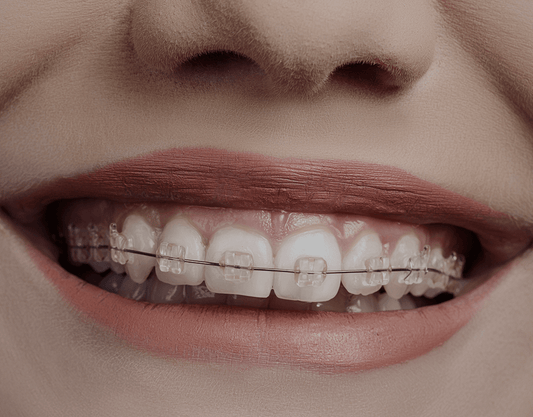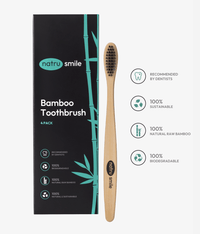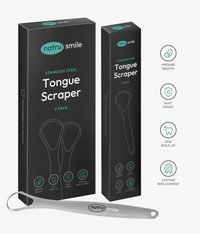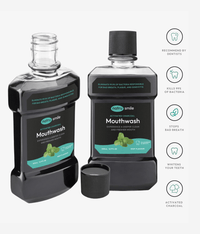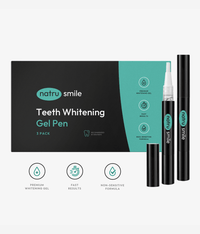
All products are certified by dental expert Dr. Greg Grillo
Teeth play a huge role in how others perceive us—a beautiful smile can do wonders for our self-confidence and overall look. And yellow teeth can indicate poor health and hygiene habits, two things no one wants associated with them.
Of course, drinks like coffee and sugary foods like candy can stain your teeth. And even with proper flossing and brushing, there are plenty of opportunities for food and debris to get stuck in the small crevices of our teeth.
Braces amplify this problem—between the brackets and wires that sit on your teeth's surface and the nasty food traps in between them, braces can make it hard to maintain a bright smile. And since they're stuck there, they make brushing even harder.
Fortunately, there are still plenty of teeth whitening options for those with braces. In this article, we'll explore five tips that can help whiten your teeth while wearing braces.
Can I Whiten My Teeth While Wearing Braces?
In short, yes. You can certainly fix yellow teeth with braces—but your options are more limited than those without braces. And the type of whitening treatments you can use depend on the type of braces you have.
Fortunately, braces have come a long way. Not all braces require you to wear massive wires over the front of your teeth. Many types, like Invisalign and ceramic braces, are nearly invisible and make brushing easier.
Lingual braces are another great option if you’d like a discreet look. These braces are similar to traditional metal braces, but they are fixed to the back of your teeth for a less noticeable effect.
In general, teeth whitening is only possible if braces do not cover the front of your teeth. If you wear metal braces, whitening procedures can do more harm than good.
Is It Easy To Whiten Teeth With Braces?
When you wear braces, plaque tends to accumulate in the crevices between brackets and wires. As it builds up, your teeth will begin to yellow due to the bacteria in the plaque.
Unfortunately, this discoloration can be difficult to remove. And depending on your brace color, they might also be very noticeable.
Whitening your teeth with braces can sometimes lead to uneven recoloration, mainly due to difficulty accessing the spaces between brackets and overlapping teeth. It's much harder for toothpaste, whiteners, and bleaching agents to penetrate these areas and achieve a uniform tone.
These factors make teeth whitening with braces cumbersome and time-consuming, but not impossible. With the proper techniques and patience, you can still whiten your teeth while wearing braces.
Can I Schedule An In-Office Dental Whitening Treatment With Braces?
In-office whitening treatments can be risky with braces for the following reasons:
- The bleaching agent used could damage the brackets and wires.
- Uneven results will occur if the dentist can't access all of your teeth.
- The bleaching agent could exacerbate oral irritation or sensitivity caused by braces.
- When the dentist removes the braces, the unwhitened parts of your teeth will be different in color from the whitened parts.
Although studies show teeth whitening procedures to be safe when protocols are followed, it's best to avoid them until after you’ve had your braces removed.
Consider talking to your dentist about professional cleaning services if you want a more immediate solution. This will help to remove any plaque or food residue stuck to your teeth, making it easier for you to achieve whiter teeth on your own.
Brushing alone won’t whiten your teeth much, but experts agree that it is still the best way to improve your dental hygiene, which can—in turn—lead to whiter teeth.
Can I Whiten My Teeth At Home While Wearing Braces?
Depending on the type of braces you wear, most dentist-administered whitening treatments may be off-limits. Teeth bleaching and laser whitening procedures, for example, would be impossible for those with metal braces.
But even with a dental consultation, most teeth whitening procedures are performed at home. Although you'll meet with a dentist to receive your treatment information and guidance, you'll be responsible for most of the actual whitening process in most cases.
For those with braces, at-home treatments are usually a better option for a few reasons:
- At-home teeth whitening allows you to prioritize the straightness of your teeth. When you have braces, the vital issue is improving the alignment of your teeth. Focusing on multiple dental issues at once can be tricky, and whitening your teeth with braces can often distract from the main task of straightening.
- At-home treatments are more convenient than dentist visits. Some whitening procedures require multiple dental appointments over the course of several weeks. This can be time-consuming and expensive if you're already in and out of the dentist's office for braces-related issues. Plus, scheduling your braces consultations might be more difficult, causing you to have them on longer than expected.
- Whitening at home integrates with your daily oral care routine. You should already brush and floss regularly to maintain a healthy smile while wearing braces. Whitening your teeth at home involves the same steps, allowing you to easily incorporate it into your existing routine.
However, whitening your teeth at home is also error-prone. Since you're the one responsible for administering the product, you'll also be accountable for any mistakes that could occur.
You also risk heightened sensitivity when using teeth whitening products, especially if your teeth hurt while wearing braces. Tooth sensitivity is the most common side effect of teeth whitening treatments, according to the American Dental Association.
To circumvent some of these issues and ensure you’re doing your best to get a whiter smile, it's still best to talk with your dentist at your next appointment.
5 Ways To Whiten Your Teeth With Braces
Braces can take a long time to straighten your teeth, especially if you have a complex case. In some instances, it is best to focus on one orthodontic issue at a time. But for others, whitening can help to speed up the process and improve your current dental care strategy.
Regardless of the type of braces you have, there are a few options you have when it comes to whitening.
1. Whitening Strips
Whitening strips are thin, flexible strips of plastic that have been coated with a peroxide-based whitening agent. These strips are typically used to improve the appearance of teeth by targeting discoloration and staining caused by aging, certain foods, drinks, or smoking.
When applied to the teeth, they can help remove surface stains and brighten the tooth’s enamel. They can also prevent new stains from forming by creating a protective barrier over your teeth.
- How whitening strips work: All you have to do is peel them off their packaging, place them on your teeth for 10-30 minutes (depending on the product instructions), and remove them. This can be done daily until you reach the end of the whitening term.
- Side effects: This study showed whitening strips to be safe, but to have the same side effects as peroxide-based whitening methods. These primarily include tooth sensitivity and gum irritation.
- Limitations of whitening strips: Whitening strips are applied to the frontal areas of your teeth and don’t reach the areas covered by braces. If you wear traditional metal braces, whitening strips are not an option.
- Costs of whitening strips: Most whitening strips cost between $30 and $50.
Whitening strips are a popular choice for those looking for a quick and relatively cheap at-home solution. Plus, they’re easy to incorporate into your daily oral hygiene routine. Unfortunately, they will not work if you wear traditional metal braces.
2. Whitening Trays
Whitening trays are thin plastic trays that you fill with whitening gel. They cover the entire surface of your teeth, including those surfaces covered by braces.
- These teeth whitening kits are the next step up from whitening strips. While they are more expensive, they’re also more effective since they cover the entire surface of your teeth.
- How whitening trays work: You will either meet with a dentist to get fitted for a tray or purchase one from an online or over-the-counter retailer. Then, fill the trays with whitening gel and wear them for as long as the instructions direct. You repeat this process until the end of your whitening term.
- Side effects: Whitening trays can cause tooth sensitivity and gum irritation, similar to those caused by whitening strips. If the peroxide content is higher (as it is in some custom trays), the side effects may be more severe.
- Limitations of whitening trays: Because they cover the entire surface of your teeth, braces and other orthodontic appliances negate their positive effects. If you have metal braces, you cannot use teeth whitening trays, even from a dentist.
- Cost of whitening trays: Whitening trays start at around $100, but dentists may charge several hundred dollars.
Similar to whitening strips, you can only consider whitening trays if you have braces behind your teeth or removable dental appliances that don’t cover the entire surface of your teeth.
3. Whitening Toothpaste And Mouthwash
Whitening toothpaste and mouthwash are excellent options for those with braces who want to get the benefits of teeth whitening without as many side effects.
Mouthwash, in particular, is an excellent addition to any oral care routine. It can help to reduce plaque, eliminate bacteria, and even whiten teeth over time. For those with braces, it can also help to dislodge and remove food particles that may be trapped in the brackets or wires.
- How whitening toothpaste and mouthwash work: Simply brush twice a day, floss frequently, and rinse with a whitening mouthwash. Be sure to read the product labeling carefully and follow their instructions for use.
- Side effects: The most common side effect of teeth whitening toothpaste and mouthwash is tooth sensitivity. Since whitening toothpastes rely on abrasion to remove surface stains, they can cause some wear and tear on the enamel.
- Limitations of whitening toothpaste and mouthwash: Some research points to whitening toothpaste as being detrimental to tooth enamel. This study disproves the efficacy of activated charcoal-based whitening toothpaste.
- Cost of whitening toothpaste and mouthwash: Whitening toothpastes typically cost between $3-$5. Mouthwashes usually range from $5 to $15, depending on the formula's strength.
Whitening toothpaste and mouthwash are accessible to all and can be used even if you wear traditional metal braces. Since they do not provide significant results, the risk of coloration differences is also lessened.
Still, there are many whitening fads out there, and some of them are marketing ploys. Do your due diligence before investing in teeth whitening toothpaste or mouthwash.
4. Electric Toothbrush
A study from SGT Dental College and Research Institute is among the many that have proven electric toothbrushes effective in removing surface stains. The mechanical action of the brush vibrates and oscillates, gently dislodging food particles and plaque that normal toothbrushes cannot reach.
Electric toothbrushes are ideal for those with braces as they can slip into tight spaces between brackets and wires to remove debris.
- How electric toothbrush works: An electric toothbrush has a rotating or vibrating head that agitates the plaque and debris on your teeth. It is battery-powered, so it requires a charger.
- Side effects: If used in too vigorous a fashion, electric toothbrushes may cause gum recession and enamel erosion. It is best to use one with soft bristles or rubberized tips to minimize these risks.
- Limitations of electric toothbrush: Electric toothbrushes cannot whiten teeth as effectively as other methods like trays, but they are an essential tool for maintaining oral hygiene.
- Cost of electric toothbrush: Electric toothbrushes can cost anywhere from $30 to $150, depending on the brand and features.
Electric toothbrushes are easy to use and are the best way to clean teeth with braces. They help prevent food particles and plaque from building up and provide a deeper clean than manual brushing.
5. Safe Whitening Options Provided By Dentists
If you don't have frontal braces, your dentist might recommend professional whitening to improve your smile. Dentists are able to use stronger concentrations of bleaching agents than professional-grade at-home trays and strips, but the methods vary depending on the individual case.
- How dentist-provided whitening works: Depending on your type of braces and your oral health history, your dentist may suggest in-office or take-home professional whitening treatments. In-office, your dentist will apply a bleaching gel, laser light, or both to the teeth. Take-home trays use concentrated amounts of hydrogen peroxide and are generally used overnight for several weeks.
- Side effects: The side effects of professional whitening may include tooth sensitivity and gum irritation. Since these procedures are more invasive to the teeth than other methods, they might aggravate existing oral sensitivity.
- Limitations of dentist-provided whitening: Dentist-provided whitening is one of the most effective options for those with deep staining, but it can be expensive and may not be suitable for everyone. Those who wear metal braces will not be able to whiten as effectively since the gel or light cannot penetrate the brackets.
- Cost of dentist-provided whitening: Professional whitening treatments can cost anywhere from $500 to $1,500 (or more), depending on your individual case.
Teeth whitening is most reliable and safe in a controlled environment (i.e., under the guidance of a dentist).
If you have braces, your dentist can recommend the most appropriate whitening methods and products that are safe for you. However, traditional braces will limit your eligibility for these procedures, as will severe sensitivity and oral diseases.
Which Whitening Options Are Safer To Use While Wearing Braces?
When it comes to whitening teeth with braces, the safest option is to use whitening toothpaste and mouthwash. Although the teeth whitening duration is longer, whitening toothpastes do not significantly impact the color of your teeth, so they are considered safe for those with covered teeth.
Whitening mouthwashes contain hydrogen peroxide, which can help remove surface stains and plaque from teeth. As long as the concentration of hydrogen peroxide is low, it is also considered safe for use with braces. And since they work to dislodge bacteria and debris, they can be beneficial for maintaining other aspects of oral health while wearing braces.
Can I Use DIY Teeth Whitening Solutions?
DIY solutions like oil pulling and baking soda can be used for teeth whitening, but they are not recommended for those wearing braces due to the potential to damage the wiring and brackets in your braces. DIY solutions can also be unpredictable and less effective than professional options, so it's best to speak with your dentist before attempting any of these methods.
It's also worth noting that most at-home solutions (aside from baking soda and hydrogen peroxide) have little to no medical or scientific backing to support their effectiveness. Instead, they rely on fads and anecdotal evidence.
The Bottom Line
Whether or not whitening your teeth is a good idea while you have braces will depend on the following factors:
- Whether your braces cover the front of your teeth
- The severity of your dental misalignment
- Your oral health (i.e., if you suffer from tooth sensitivity or oral diseases)
- The cost of your whitening treatment
- The severity of your staining
In some cases, it might be best to hold off on teeth whitening until after your braces are removed. But if you can afford it and have braces that permit whitening treatments, your dentist may suggest in-office or take-home professional whitening as the safest and most effective option.
Regardless of which method you choose, taking proactive measures to improve your oral health will help you achieve whiter teeth. Using an electric toothbrush, mouthwash, and flossing regularly can help reduce plaque and staining and keep your teeth healthy.
Want to know more? Here are a few questions our customers frequently ask us:
Why Do Teeth Become Discolored While Wearing Braces?
There are several reasons teeth become discolored while wearing braces:
- Metal wiring and brackets can trap food and bacteria, creating a breeding ground for plaque.
- Because the brackets and wiring act as an anchor for the teeth, they can make it harder to brush away staining substances.
- When pigmented foods and drinks come in contact with braces, their impact is magnified.
- Fewer whitening options are available to those who wear braces.
How Can You Prevent Teeth Staining When Using Braces?
To prevent staining while wearing braces, use the following tips:
- Avoid or limit consumption of highly pigmented foods and drinks.
- Drink fluids through a straw when you can.
- Brush teeth regularly and thoroughly with an electric toothbrush, paying extra attention to the areas around brackets and wires.
- Floss daily to remove any food particles or plaque that may have become trapped between teeth.
- Rinse your mouth after eating with a fluoride-based mouthwash.
- Consult your orthodontist to discuss whitening options that are safe for use with braces.
Can You Use Whitening Toothpaste With Braces?
Whitening toothpastes are no more or less safe for use with braces than for use in other applications. Some studies point to a lack of efficacy compared with other whitening options, but many people find them helpful in reducing surface-level discoloration. Be careful when choosing a whitening toothpaste, and look for baking soda or hydrogen peroxide over activated charcoal, and be mindful of your tooth sensitivity levels.
Should You Whiten Your Teeth After Braces?
Many people choose to have their teeth professionally whitened after having their braces removed. Since most braces cover a large area of the teeth, inconsistencies in coloration across the entire smile become clear once the braces come off. Professional whitening helps even out the color of your teeth, and since you won't have any brackets or wires to worry about, it's a relatively safe procedure to undergo.
Can I Use Whitening Strips With Braces?
If you wear regular metal braces, you cannot use whitening strips to whiten your teeth. Whitening strips rely on direct and sustained contact with the enamel surface, which is impossible when wearing brackets and wires. There are special orthodontic whitening codes available for people who wear clear aligners or lingual braces that allow for safe use of whitening strips. If you have any questions about the safety of a particular whitening product, consult your orthodontist for advice.

